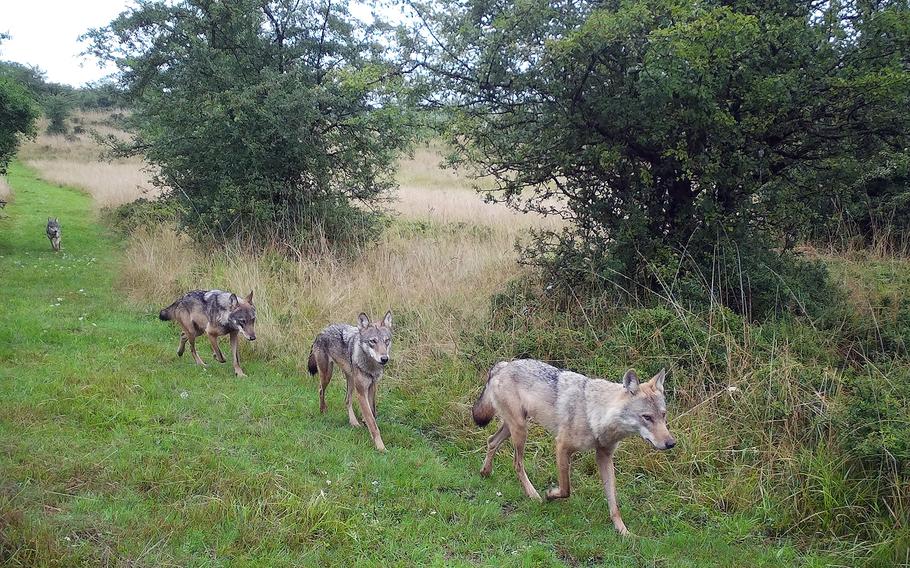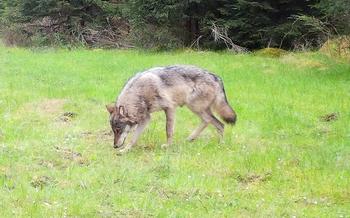
A pack of European gray wolves moves through the U.S. Army training area in Grafenwoehr, Germany, in a photo captured by a trail camera July 8, 2023. (Federal forestry office Grafenwoehr)
GRAFENWOEHR, Germany — A population of European gray wolves, a species hunted to extinction in Germany by the end of the 19th century, is now thriving in the vast expanse of the U.S. Army training range in this Bavarian town.
Following the arrival of a pair of wolves in 2016, their number at the Grafenwoehr Training Area has grown to at least 17 in what appears to be two distinct packs. That tally is expected to grow in the coming weeks as pups emerge from their dens and are spotted by trail cameras.
The 90-square-mile training area, home to the 7th Army Training Command, is the service’s largest in Europe. Its unspoiled forest is home to numerous food sources for wolves, including red and roe deer, wild boars, beavers and otters.
“Wildlife really has a paradise out there,” said Stefan Haertl, an environmental engineer for U.S. Army Garrison Bavaria. “There is no disturbance by tourists or (dog walkers). They have adjusted to firing or tanks moving.”
Alexander Krone, head of Germany’s federal forestry service in Grafenwoehr, said the ranges also have low speed limits, making crashes involving a wolf unlikely. Soldiers are given a field card with instructions should they have an encounter with one.
The animal has made a comeback in the country in the years since the 1990 passage of the Federal Nature Conservation Act, which affords wolves the highest protection status and makes it illegal to kill them, Krone said.
Lone wolves began to trickle in from eastern countries like Poland after World War II, Krone said. However, hunting was allowed in the former East Germany, largely stopping them from moving west.
After the Berlin Wall fell in 1989 and conservation efforts took shape in the wake of German reunification, the species expanded to new territories. Now wolves come from all directions, Haertl added.
“We estimate we have stable territories of two reproducing females,” Krone said of the Grafenwoehr population. “I think we have to accept that the wolf is here.”
Through April 2023, there were 1,339 wolves in 184 packs reported across Germany, up from 1,175 wolves in 161 packs the previous year, according to data from Germany’s Federal Office for Nature Conservation.
The animals are not considered a threat to humans or livestock if the appropriate precautions are taken, Krone said. Information is the key to avoiding conflict.

A female European gray wolf is captured by a trail camera on March 5, 2024, while moving through the U.S. Army training area in Grafenwoehr, Germany. (Federal forestry office Grafenwoehr)
Wolves are naturally afraid of humans, according to a federal forestry service fact sheet. They will remain elusive unless they feel threatened or become accustomed to humans by being fed or stumbling upon discarded food. Domesticated dogs should be kept on a leash while walking in the forest, especially during mating season months of February and March.
After a wolf killed a sheep off base a few years ago, shepherds and farmers were asked to put safeguards in place to protect livestock, Haertl said. Electrified fences and highly trained guard dogs now protect herds.
Since then, there haven’t been any incidents, but even so, public sentiment in the Grafenwoehr area remains mixed, Haertl said.
Anyone who sees a wolf in the wild should remain calm and give the animal time to retreat, according to the forestry service fact sheet. Make noise like clapping or shouting if the wolf gets too close and throw stones or sticks as a last resort.
“No one has to be afraid of being attacked by a wolf,” Haertl said. “If you know you live in a wolf territory, like we do around the training area,” it’s just a matter of following the rules.